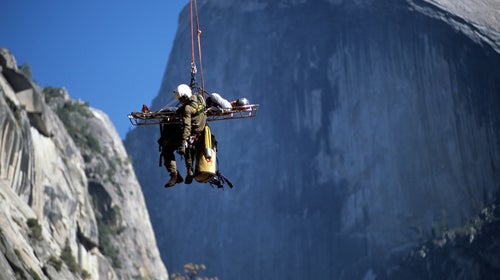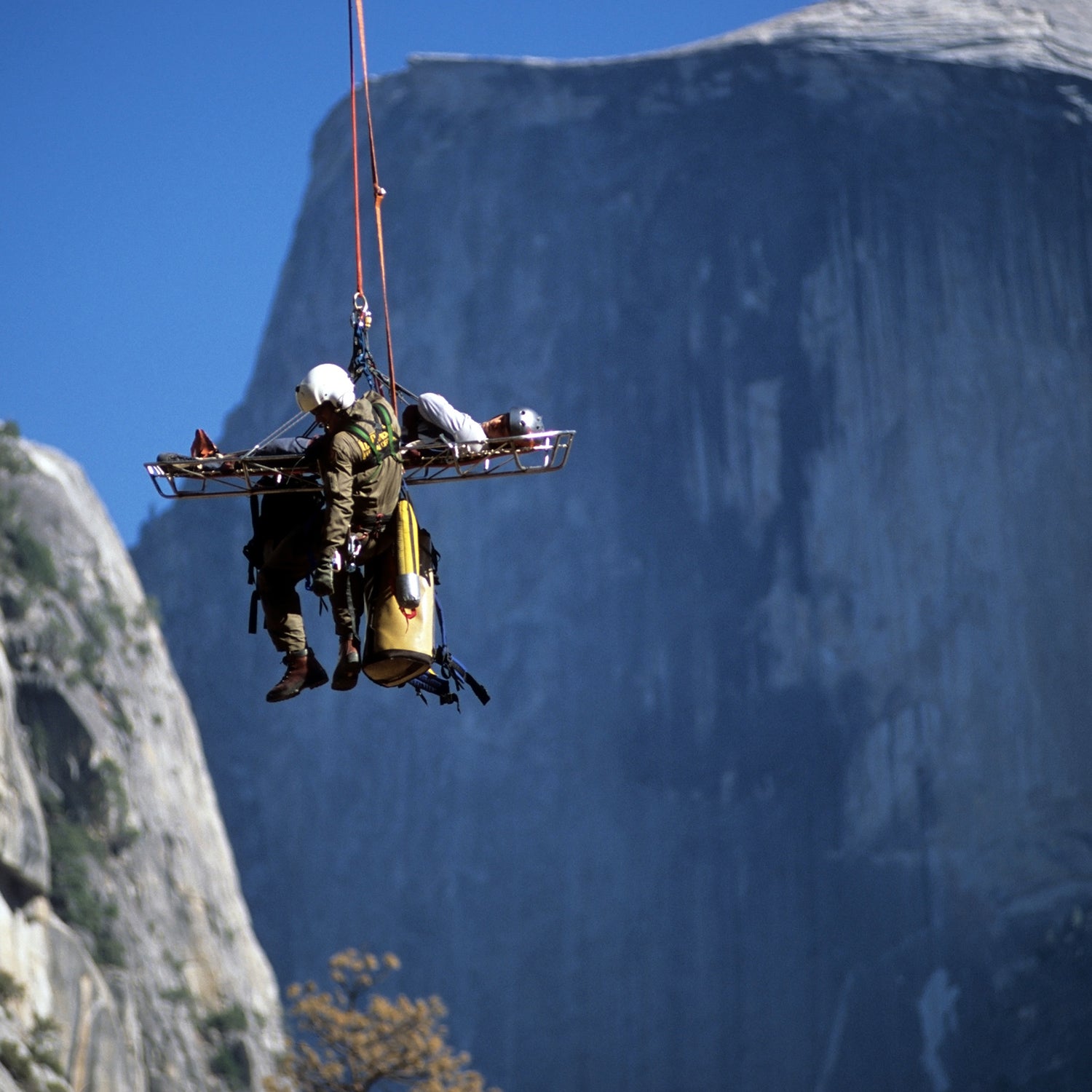Yosemite National Park is home to some of the nation’s most beautiful natural features that can turn deadly with just one wrong step. In Big Walls, Swift Waters, search and rescue veteran Charles R. “Butch” Farabee goes deep on all the ways visitors get into trouble in the park—and the heroic efforts of the SAR teams who try to help them. Excerpted here are three true stories.
A Rescue with Multiple Challenges
At sunrise on Saturday, September 23, 1972, climber Neal Olsen was leading a difficult section on the 24th pitch of the Nose route on El Capitan, just above Camp V—a set of ledges about 900 feet below the top of the cliff. In an unlucky accident, he pulled a 125-pound boulder down on himself. He tried to dodge it, but it still glanced off his head and back before striking his right leg and smashing it badly.
By 7:30 that morning, Yosemite SAR officer Pete Thompson was organizing one of the most demanding rescues in the history of North American mountaineering. Pete had an A-team of six local climbers in his office: Jim Bridwell, Bev Johnson, Tom Gerughty, Roger Breedlove, John Dill, and Loyd Price. Their mission: to develop an initial rescue plan, estimate equipment needs, and identify other technical climbers they wished to take with them. The idea was to lower a rescuer from the summit 900 feet down to the stricken climber. Then Olsen and his rescuer would be lowered to medical staff on the Valley floor, 1,800 feet below. At the time, only one other long-lowering rescue even remotely similar to this one had ever been performed, in Grand Teton National Park in August of 1967. In total, 18 men and one woman—Bev Johnson—would be flown to the top of El Cap that day.
The team’s task was made even harder as a result of a disastrous incident earlier that summer. Seven weeks before, just past midnight on August 1, 1972, a 17-year-old boy had torched the many tons of stacked hay in the government’s horse barn. The barn and stables were lost, as were another seven older wooden structures.
One of these terribly flammable CCC-era buildings held the Valley SAR cache. Ropes, webbing, pitons, bolts, carabiners, sleeping bags, rain gear, and related, vital equipment all went up in smoke. Thompson knew they were short on the right sorts of equipment to pull off a rescue of this size and complexity.
To this day, a now-long-retired Pete Thompson is not exactly sure how the park ended up with some of what it got that day. The most interesting were the large rolls of one-half-inch rope. Tubbs Cordage, a yachting and sailing line manufacturing company in the San Diego area, sent two 4,400-foot-long rolls and three 1,200-foot-long rolls of Goldlon, each tightly wound around a wooden spindle. Although plenty strong, the rope was not intended to take the kind of abuse it would be subjected to.
The ropes were driven by local police departments to nearby El Toro Marine Air Station. They were then flown to El Cap Meadow in two large, twin-rotor CH-46 helicopters. Other retail outdoor companies in the Bay Area, such as the Ski Hut and The North Face, sent real climbing rope, as well as a seemingly endless supply of colored nylon webbing, hundreds of carabiners, 150 bolts, dozens of pitons, piton hammers, water bottles, dried food, and other long accessory lines and cords. These purchases were all picked up by the Bay Area Mountain Rescue Unit and transported by the California Highway Patrol.
They knotted together enough ropes to create two 3,000-foot lengths.
Before they returned to their home base at El Toro that evening, the Marine Corps flew more equipment and manpower to the staging scene on top of El Capitan. There was a pile of equipment on the peak that night that had to be sorted and then placed in the right spot for the next morning. During the height of the stretcher lowering later in the day, several hundred people stood along the road and in the meadow, at the base of El Cap, most with their binoculars pointed toward the light-brown cliff.
Six of the Camp 4 SAR-site climbers, including Bev Johnson, rappelled down to Camp V that first afternoon. Up top, the climbers knotted together enough ropes to create two 3,000-foot lengths. One rope made a directional change at the victim’s tiny ledge far below; the other ran straight from the final lip of El Capitan to Olsen’s litter, attended by Camp 4 superstar Jim Bridwell. Although it took more than 36 hours to fully orchestrate, once underway it took only 90 minutes for the two to be lowered down the remaining 1,800 feet of sheer cliff. It went off without a hitch. The five still on the ledge, as well as Olsen’s partner, elected to come down that night, after dark. Al Garza, the park’s chief electrician, built a huge light bank and illuminated almost the entire face of the great cliff. Neal’s leg healed, and he continued to climb for the next four decades.
The Best of Intentions
Just before 6 a.m. on May 25, 1991, 44-year-old Elaine Watson of Compton, California, was driving up Southside Drive. Along this stretch, the road passes within a dozen feet of the Merced River. That morning, it was in near flood stage, flowing deep and fast. In the Toyota Camry with Watson that morning were her 62-year-old mother, Pearl, her two nephews, 3-year-old Mario and 5-year-old Lance, and her 7-year-old niece, Sequoia. As she headed east into the Valley, perhaps she nodded off at the wheel.
The car left the road and quickly bounced down the boulder-strewn riverbank, splashing into the water at the head of a long, whitecapped rapid. It floated for 60 feet, finally becoming lodged facing upstream against a logjam, 25 feet from shore. The frigid waters now boiled up over the submerged engine compartment, pushing the vehicle deeper into the river. A man who had been driving immediately behind them stopped and yelled to them to stay put while he went for help. Moments later, four more tourists stopped. One threw Watson a rope, and these good Samaritans yelled and signaled they would pull them all to shore, one by one. This was a mistake.
Watson knotted the line around her niece Sequoia, who jumped into the river and was safely pulled to shore. But Mario and Lance, seeing their older sister leap into the water, immediately followed suit without waiting for the rescue rope. Both tiny boys quickly bobbed out of sight downstream on the two-foot-high waves of the swollen Merced. With little hesitation or regard for her own safety, Watson plunged into the river to save her two young nephews.
One threw Watson a rope, and these good Samaritans yelled and signaled they would pull them all to shore, one by one. This was a mistake.
As luck would have it, Ranger Dave Panebaker heard the call come in: “CAR IN THE RIVER.” Within 13 minutes of hearing the radio report, Dave was on scene.
Watson’s mother, Pearl, was still immersed to midthigh in the river, becoming hypothermic but otherwise unhurt. The force of the rushing water had pinned her legs tightly between the car body and its open front door, keeping her from being swept away. Quickly wiggling into his wetsuit and dragging a safety rope behind him, Dave swam out to the terrified woman. He could not wait for backup. Dave cradled Pearl to warm her while shielding her from the current until more rescuers could arrive. Once they did, Pearl was quickly hauled to shore. Searchers were soon in the rushing water as well as combing the shore for the two boys and their aunt.
Two hours after the accident, Elaine Watson was found. But despite CPR by rangers, Watson—the would-be rescuer—was pronounced dead. First responders dread nothing more than the death of a child, and a huge search was mounted for the little boys. Two weeks after five-year-old Lance bobbed downstream, his body was found. Three long months later, the skull of seven-year-old Mario was discovered lodged in some driftwood among the boulders.
Rescuing the Rescuers
It was a nice day, with the forecast predicting a beautiful day, I convinced my fellow ranger and good friend Mark to go on a snowshoe hike. It was all downhill and about four miles by the map. From near Badger Pass (the park’s downhill ski area), we’d drop into the Bridalveil Creek drainage and exit with a short rappel into the Valley over the Gunsight, a notch in the cliffs near the top of Bridalveil Fall. I used my four-foot-long beavertail snowshoes, and Mark was similarly equipped. We had ropes, bolts, drills, and a piton hammer, as well as a two-way park radio and basic bivouac gear. With blue skies above and fresh snow below, off we went on our day trip.
We easily worked down into the drainage and along the creek. Then our luck turned. At noon and way past the point at which we should have turned around, our death march commenced. With each step, the webbing on our feet would catch the six-foot-high, snow-buried manzanita bushes, and we started plunging down between their brittle branches. Climb out, snag, tumble in. For hours. Climb, snag, fall. Sweat rolled off us, and we became chilled. As darkness fell, we finally made the Gunsight. “We’re OK,” we radioed our boss. “We can see the Valley and have a boulder for shelter, a small fire, and we’ll sit on snowshoes and ropes.” Then began the worst storm of the season: for us it was an all-night mix of rain and snow.
The next morning, I broke five drill bits—all we had—due to icy water trickling down the cliff face, so we weren’t able to place an anchor. So, no rappel.
With each step, the webbing on our feet would catch the six-foot-high, snow-buried manzanita bushes.
A fellow ranger advised us by radio to go up canyon to another exit spot requiring no rappels; it took us a second grueling day of hiking across the snowshoe-grabbing manzanita to get there. The storm began again, and our escape spot became hidden by low clouds. A second bivouac.
With a tiny fire, the boulder we sheltered by gave us just enough refuge. “We’re still OK,” we radioed. This time, however, our boss did not believe us. Unbeknownst to Mark and me, he pulled together seven of the leading local mountaineers to bring us home. Also in the rescue party was another ranger friend; his job was to bring the emergency food. Not known for his wilderness skills, he lugged in 20 cheeseburgers—which arrived all smashed together.
Splitting into two teams and approaching from different directions, our rescuers climbed all night, battling the deep snow and driving wind. But until we heard their faint voices on the radio, we did not even know they were nearby. They were definitely beat, but we were truly glad to see them and the cheeseburgers. We were down 12 hours later.
Excerpted by permission from Big Walls, Swift Waters: Epic Stories from Yosemite Search and Rescue by Charles R. “Butch” Farabee (Yosemite Conservancy). Available wherever books are sold.

